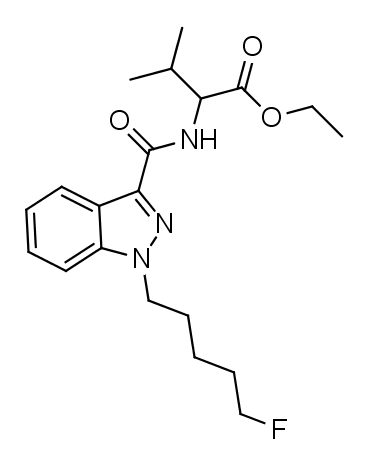Summary
5F-EMB-PINACA, alternatively referred to as EMB-5F-PINACA by the naming conventions of synthetic cannabinoids outlined by the EMCCDA, and also known as 5F-AEB, is a synthetic cannabinoid derived from the indazole-3-carboxamide family. This compound has been marketed as a designer drug and is readily available for purchase online.
The EMCDDA brought attention to 5F-EMB-PINACA when it was discovered during the seizure of 149 grams of white powder in Sweden in April 2015.
| Identifiers | |
|---|---|
| IUPAC name | |
| CAS Number | None |
|---|---|
| ChemSpider | 58191441 |
| UNII | 64OSW0N4YB |
| Chemical and physical data | |
| Formula | C20H28FN3O3 |
| Molar mass | 377.460 g·mol−1 |

Legal status
5F-EMB-PINACA is illegal in Sweden as of 26. January 2016.
FAQ
1. What is 5F-EMB-PINACA?
- 5F-EMB-PINACA is a synthetic cannabinoid belonging to the indazole-3-carboxamide family, often used as a designer drug.
2. What are the effects of 5F-EMB-PINACA when consumed?
- The effects of 5F-EMB-PINACA can include altered perception, relaxation, and euphoria. However, it may also lead to adverse effects like anxiety and an increased heart rate.
3. Is 5F-EMB-PINACA legal to use?
- The legal status of 5F-EMB-PINACA varies by country and jurisdiction. It has been banned in many places due to safety concerns.
4. What risks are associated with the use of 5F-EMB-PINACA?
- Using synthetic cannabinoids like 5F-EMB-PINACA can be risky, with the potential for addiction, unpredictable side effects, and harm to mental and physical health.
5. How was 5F-EMB-PINACA discovered?
- 5F-EMB-PINACA gained attention when the European Monitoring Centre first reported it for Drugs and Drug Addiction (EMCDDA). It was found during a seizure of 149 grams of white powder in Sweden in April 2015.
6. Can 5F-EMB-PINACA be detected in drug tests?
- Yes, 5F-EMB-PINACA can often be detected in standard drug tests, as it is chemically similar to THC, the psychoactive component of cannabis.
7. Is 5F-EMB-PINACA considered safe for use?
- No, it is not considered safe for consumption. The use of synthetic cannabinoids carries significant risks due to their unpredictable nature and potential for adverse reactions.
8. Where can I find more information about 5F-EMB-PINACA?
- For further information and guidance regarding 5F-EMB-PINACA, it is recommended to consult with local health authorities, substance abuse professionals, or drug education resources. Staying informed is crucial for making responsible choices.
References
- In a comprehensive publication authored by Pulver B, Fischmann S, Gallegos A, and Christie R in Drug Test Analysis (2023), an in-depth examination of the EMCDDA framework and practical guidance for naming synthetic cannabinoids is presented. This publication is instrumental in understanding the nomenclature intricacies in the realm of synthetic cannabinoids. [Reference: Pulver B, Fischmann S, Gallegos A, Christie R. EMCDDA framework and practical guidance for naming synthetic cannabinoids. Drug Test Anal. 2023;15(3): 255‐276. doi:10.1002/dta.3403]
- “5F-AEB” was identified and documented by Cayman Chemical, a significant player in chemical research, providing insights into this specific compound. [Reference: “5F-AEB”. Cayman Chemical. Retrieved 10 August 2015]
- The United Nations Office on Drugs and Crime (UNODC) reported the emergence of fifteen novel synthetic cannabinoids to UNODC EWA at the beginning of the year, highlighting their role in monitoring and reporting on emerging psychoactive substances. [Reference: “UNODC EWA: Fifteen novel synthetic cannabinoids reported to UNODC EWA since the beginning of the year”. United Nations Office on Drugs and Crime (UNODC). Retrieved 10 August 2015]
- “EWS_EU / AT: checkit; neue psychoakt. Subst” is an information resource managed by Gesundheit Österreich GmbH, offering insights into new psychoactive substances. It contributes to public health efforts by tracking and reporting on these substances. [Reference: “EWS_EU / AT: checkit; neue psychoakt. Subst”. Gesundheit Österreich GmbH. Retrieved 10 August 2015]
- In November 2015, the Swedish public health agency, Folkhälsomyndigheten, considered classifying 31 new substances as potential narcotics or health-endangering materials, underscoring their commitment to public safety. [Reference: “31 nya ämnen kan klassas som narkotika eller hälsofarlig vara” (in Swedish). Folkhälsomyndigheten. November 2015]